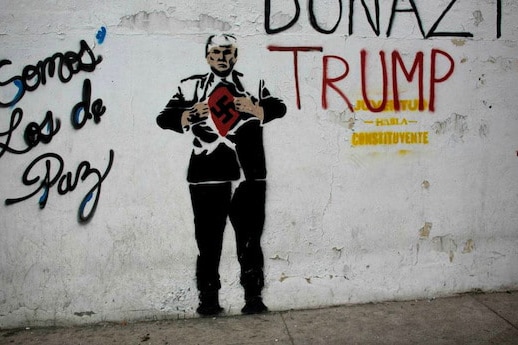In this MPN exclusive, we speak to Monthly Review editor John Bellamy Foster and Latin America studies scholar Harry L. Simón Salazar about the U.S. fight to maintain hegemony in Latin America, the rise of the right wing, and the danger of “regime change” in Venezuela.
It’s certainly talking like it is. In February, U.S. Secretary of State Rex Tillerson toured the region in a bid to drum up support for Washington’s regime-change agenda in Venezuela. He began the tour in a bizarre fashion, celebrating the relevance of the long-expired 1823 “Monroe Doctrine.” In effect, Tillerson was asserting — with typical Trump administration hubris — Washington’s sovereignty over the entire Western Hemisphere, a response to China’s regional presence.
Washington’s bellicose tone comes amid a regional resurgence of the neoliberal right wing that has seen the once-dominant left—gathered under the banner of “Socialism of the 21st Century”—face multiple setbacks across Central and South America.
Despite its growing structural weakness and international isolation, the U.S. is still willing to do what it can to retain primacy in its historical “backyard,” the Western Hemisphere. Its current wounded-beast insecurity is only forcing it to desperately rethink its strategic approach.
Speaking to MintPress News, sociology professor at the University of Oregon and Monthly Review editor John Bellamy Foster said:
U.S. economic hegemony is in decline and Washington is using every means at its disposal to develop its geopolitical and geoeconomic power — that is, its imperial power — as a way of countering this decline.
The biggest current thrust in U.S. military and imperial strategy circles is directed at the articulation of what is called geoeconomic warfare as a definite strategy and as a means to geopolitical power. This involves the development of a whole new arsenal of weapons.
21st century socialism: from red dawn to star-spangled dusk?
“What is taking place today across Latin America comes in the wake of an unusually long period of progressive advancements across the region,” author and University of California San Diego lecturer Harry L. Simón Salazar told MintPress News.
Continuing, Simón explained:
What was labeled by the bourgeoisie as the ‘pink tide’ can be tracked as beginning in the mid-to-late 1990s as a leftist trend that influenced regional politics for approximately 20 years, with the right wing increasingly isolated and limited to operating with impunity within Colombia, Florida, and Mexico. The leftist trend that spread across Latin America was primarily institutional and electoral, developing within the framework of diminished neoliberal states across Latin America and often influenced by Bolivarian oil wealth.
In 1998, Hugo Chavez was elected president of Venezuela, signaling what he called at the time a “social revolution.” He soon became the ideological lodestar of the new 21st-century socialist trend. By 2009, eight out of 10 South American governments were ruled by leftist parties backed by social movements, indigenous communities, and the traditional socialist and communist left. For a time, these social-democratic administrations proved massively popular and won more votes and elections than any prior government.

People hold up images showing Fidel Castro, second from right, Venezuela’s late President Hugo Chavez, center, and Cuba’s revolutionary hero Ernesto ‘Che’ Guevara, bottom left and right, during a May Day march in Revolution Square in Havana, Cuba, Wednesday, May 1, 2013. The image of Chavez carries the words in Spanish “Chavez : Our best friend.” (AP Photo/Ramon Espinosa)
To differing degrees, these governments broke with the Washington consensus of unquestioned market rule and focused more on the social, economic, and cultural rights of regional populations. In the spirit of what was called buen vivir (good living), the state strengthened its role — as social investment, labor market regulations, and other progressive reforms redistributed income and lifted tens of millions of people out of poverty and into a new middle class. Even sections of the capitalist class in these countries were forced to begrudgingly accept these positive results and, in many cases, conservative and pro-U.S. electoral parties were delegitimized and pushed to the margins.
Multilateral institutions like the Washington-based Organization of American States and the World Trade Organization were likewise marginalized, as intergovernmental groups like Union of South American Nations (UNASUR), the Bolivarian Alliance for the Peoples of Our America (ALBA), and the Community of Latin American and Caribbean States (CELAC) were forged. Meanwhile, the China Development Bank and Beijing-led Asian Infrastructure Investment Bank increasingly took over the role of the Inter-American Development Bank, World Bank, and IMF.
The past several years have taken a grim toll on the Latin American left. As the popularity of incumbent left-of-center governments sagged, neoliberal presidents came to power in Argentina, Chile, and Peru through electoral means. In other countries, right-wing forces managed to devise new strategies beyond simply getting out the vote: in Paraguay and Brazil, leftist administrations were impeached in parliamentary coups that made way for pro-U.S. governments. In Ecuador, President Lenín Moreno—fresh from narrowly being elected with outgoing leftist leader Rafael Correa’s support—quickly used the “anti-corruption” rhetoric of the right-wing opposition to purge the ruling party of Correista “Citizen’s Revolution” stalwarts through unconstitutional means.
Colombia’s FARC insurgents have disarmed in a peace deal widely criticized by the right, but killings and disappearances targeting rural activists and social movement organizers have continued unabated. Most recently in Honduras, the U.S. threw its weight behind the illegitimate and widely-resisted reelection of Juan Orlando Hernández.
Simón explained:
The current imperial/neoliberal offensive taking place across Latin America shares what might be labeled as an insurgent quality — the willingness among derechistas [rightists] and their U.S. sponsors to dismantle what is left of the neoliberal state, particularly any leftist manifestation of it, however innocuous it may be.
In some cases, notable right-wing elites, landlords and local oligarchs like former Colombian President Alvaro Uribe are hardly distinguishable from mafiosi, and retain their seats in power despite their close ties to fascistic paramilitaries and death squads tied to the drug trade.
In Venezuela, the government of President Nicolas Maduro has struggled with plummeting oil prices and sabotage that has paralyzed sections the economy and empowered the U.S.-backed opposition. The U.S. is now openly discussing a “military option” while urging officers in the Venezuelan military to act as “the agent of change” in a manner similar to Augusto Pinochet’s violent overthrow of Chilean President Salvador Allende in 1973.
“In some Latin American countries this insurgent right wing [is] striking out against populations using methods not seen since the days of Operation Condor and the counterinsurgent wars of the 1980s,” Simón noted, continuing:
Latin American reactionary elites [are] demonstrating a class-based consensus that there is no need to mask their current power grabs with bourgeois legality, and instead they demonstrate a willingness to disrupt the constitutional order and tear apart ‘el tejido social’ [the social fabric].
Meanwhile, China has continued to consolidate its presence in the region while forging close economic relationships with Latin American and Caribbean governments, irrespective of whether they lean left or right. Beijing’s repeated assertions that “Latin America is the natural extension of the 21st-century Maritime Silk Road” were without a doubt seen in Washington as an implied strategic threat to the U.S. and a signal of its receding power in Latin America.
“The object of the continued incorporation of Latin America within the U.S. Empire has remained consistent, though the methods in which this has been approached have naturally varied depending on historical circumstances,” Foster explained.
“America First” meets the Monroe Doctrine
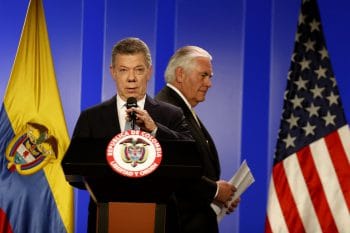
In this Feb. 6, 2018 Photo, Colombia’s President Juan Manuel Santos, front, and U.S. Secretary of State Rex Tillerson arrive to hold a press conference after a meeting at the presidential palace in Bogota, Colombia. (AP Photo/Fernando Vergara)
In a speech kicking off his Latin America tour last month, Tillerson hailed the Monroe Doctrine for being “as relevant today as it was the day it was written.” The announcement was a direct reversal of former President Barack Obama’s policy signaling that the era of U.S. military intervention in the region was over—a declaration “worth applauding,” as Tillerson’s predecessor John Kerry told the Organization of American States in 2013.
Liberal beltway analysts saw Tillerson’s speech as a gaffe and possible result of a shortage of regional experts in his State Department, yet the assertion brought a sense of foreboding to critics of U.S. imperialism.
“U.S. imperialism in Latin America is of course nothing new, now going back at least two centuries, with the [bicentennial] anniversary of the Monroe Doctrine only five years away,” Foster explained, continuing:
The Monroe doctrine, which has frequently been glorified in the United States almost as an ancillary to the Constitution, is primarily a declaration of U.S. hegemony over Latin America, and against any interference in the region by powers outside the Americas. It has been used to justify U.S. imperialism, including military interventions, in the region over a period of two centuries.
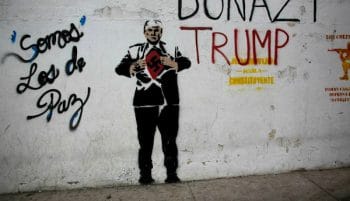
A mural of U.S. President Donald Trump depicting him wearing a Nazi swastika covers a wall along a sidewalk in Caracas, Venezuela, Nov. 14, 2017, along with the Spanish message: “We are those of peace.” (AP/Ariana Cubillos)
When the Monroe Doctrine was authored by then-Secretary of State John Quincy Adams in 1823, Washington claimed that it was necessary to prevent a European imperial presence in the Americas. The doctrine was eventually extended to Hawaii and the Philippines. Throughout the 20th century, the doctrine was used to justify U.S. imperialism’s fight against socialist and communist governments and national liberation movements seen as friendly toward the Soviet Union.
In his landmark 1944 analysis, Behemoth: The Structure and Practice of National Socialism, German political scientist Franz Neumann laid out how Nazi Germany saw the American exceptionalist assertions in the Monroe Doctrine as a model for geopolitical hegemony — unlike traditional international law, which was seen as a “creation of the Jews and as a cloak for British imperialism.” For the ideologists of Nazi-era geopolitics, the Monroe Doctrine became a justification for Germany’s own grossdeutsche Reich. Neumann explained:
The Monroe Doctrine [became] ‘the most successful example of a large-scale principle in international law’…Ever since the first Hague Peace Conference of 1909, the United States has insisted that the Monroe Doctrine occupies an exceptional position…In German hands, the exception now becomes the rule. There is no longer one international law but as many as there are empires, that is, large spaces. The grossdeutsche Reich is the creator of its own international law for its own space. Interventionists must keep their hands off.
The policy is now being reimagined as an “America First” imperialist strategy to reduce Chinese investment in the region—in Tillerson’s words, to prevent China from using its “economic statecraft to pull the region into its orbit.”
The geoeconomic battle with China for the Americas
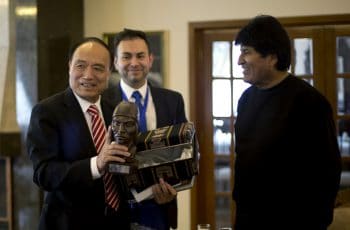
Bolivia’s President Evo Morales, right, gives a handcrafted bust of Bolivia’s indigenous leader Tupac Katari to Houlin Zhao, left, from China, Secretary General of the International Telecommunication Union, ITU, during a meeting at the presidential residence, in La Paz, Bolivia, Friday, Oct. 13, 2017. (AP Photo/Juan Karita)
Tillerson’s remarks were a result of ongoing discussions in Washington about how best to reassert the U.S.’s flagging economic and military power, Foster noted, pointing to the “the hottest book in U.S. imperial circles”—the Council on Foreign Relations’ War by Other Means: Geoeconomics and Statecraft.
In the 2016 book, authors Robert D. Blackwell and Jennifer M. Harris highlight China’s threat to U.S. hegemony in the region, unfavorably comparing Washington’s coercive power to Beijing’s ability to offer development assistance and condition-free aid to increase its geopolitical leverage:
More and more states are waging geopolitics with capital, attempting with sovereign checkbooks and other economic tools to achieve strategic objectives that in the past were often the stuff of military coercion or conquest…The United States has no coherent policies to deal with these Chinese geoeconomic actions — many of which are aimed squarely at America’s allies and friends.
… [A]s economic techniques of statecraft have become a lost art in the United States, the rest of the world has moved in the opposite direction. Russia, China, and others now routinely look to geoeconomic means, often as a first resort, and often to undermine American power and influence. In ignoring the ever-greater role of geoeconomics in the international system, the United States squanders opportunities and dilutes its own foreign policy outcomes…It gives China free rein in vulnerable African and Latin American nations.
“So the Monroe Doctrine is now being revived and reinterpreted to extend to geoeconomic statecraft and warfare,” Foster said. “The United States is essentially insisting on its total economic as well as military domination of its Latin American ‘backyard.’” Foster added:
I believe that Venezuela in particular has become a test case for this new strategy of geoeconomic warfare. But it is not just Venezuela that is the target, and in different places different weapons are used.
With the U.S. embroiled in various “regime change” efforts and low-intensity conflicts across the globe, aimed at securing its dominance—a state of perpetual warfare known to Washington policymakers as the New Thirty Years War—the U.S. capability for a direct military intervention against the formidably-armed National Bolivarian Armed Forces of Venezuela has been significantly eroded. Even Trump, surrounded as he is by former top-brass generals like Defense Secretary James “Mad Dog” Mattis, can understand this.
An asymmetric approach is thus a preferred option to effect “regime change,” Foster explained, continuing:
The U.S. strategy in Latin America has been to focus on altering various parameters in its favor, weakening and dividing Latin American states, and diminishing China’s role…Isolation of Venezuela and the other ALBA states is key, with the U.S. exerting pressure for coups or even military intervention by a combination of states. [For example], the Venezuela opposition has been promoted under the mantle of a ‘civil society’ revolt.
Mediated terror
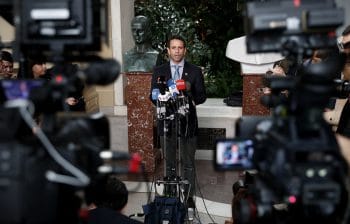
Venezuelan opposition leader Henrique Capriles speaks to members of the media following his meeting with Organization of American States (OAS) Secretary General Luis Almagro, at the OAS building in Washington, Friday, March 31, 2017. (AP Photo/Pablo Martinez Monsivais)
For Harry L. Simón Salazar, the current U.S. neoliberal offensive in Latin America is increasingly becoming a role assigned to the mass media. Even In countries like Ecuador and Venezuela, media outlets remain in the hands of either U.S.-based transnational corporations or Washington- and Miami-loyal elites.
In his recently-published book, Television, Democracy, and the Mediatization of Chilean Politics, Simón analyzed Chile’s 1990 transition from Pinochet-era dictatorship to civilian rule. In Simón’s view, the 1988 Franja de Propaganda Electoral campaign was a case study of how the media plays a key role in proliferating neoliberal cultural values and the “politics of the possible” in the minds of the populations.
The campaign was a collaborative effort between the outgoing dictatorship and the democratic opposition. In the 2012 Chilean film, No, it was memorably portrayed as the crass product of an advertising agency.
Simón explained:
Since the late 1980s, Latin American mass media was not just instrumentalized by the right to frame political struggle, but it became a mass media that often became the central field of political struggle primarily for the right wing (with a few cases for the left), with organized parties and organizational forms assigned a secondary position.
His perspective was underscored by former Ecuadorian President Rafael Correa in a recent opinion piece for Cuba’s Granma daily, where the once overwhelmingly popular and now widely-defamed leader stressed:
Our democracies should be called mediated democracies. The media are a more important component in the political process than the parties and electoral systems; they have become the main opposition parties of the progressive governments, and they are the true representatives of business and conservative political power.
It does not matter what best suits the majorities, what has been proposed in the election campaign, and what the people — the main actor in every democracy — has decided at the polls. The important thing is what the media approve or disapprove of in their headlines. They have replaced the Rule of Law with the State of Opinion.
Simón, like Correa, sees this new reality as an important moment for self-criticism and the need to examine the actual feasibility of breaking from imperialism’s grip through peaceful democratic means:
We must reconsider the relative importance of electoral struggle within the context of the neoliberal bourgeois state, and as part of the Latin American left we must put into balance this history and reconsider our priorities.
If neoliberalism in Latin America proved to be so resilient as to survive the so-called ‘pink tide’—and be capable of rising up and pushing back the progressive gains of the past 20 years—then it is essential that we understand that its power and influence weren’t just a function of presidential and constitutional power alone.
Venezuela versus the “giant with feet of clay:” a new David versus Goliath?
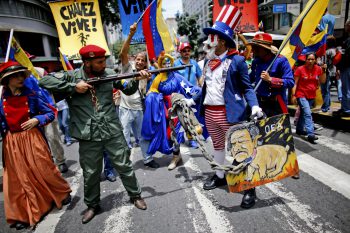
In this Monday, Aug. 14, 2017 photo, government supporters perform a parody involving a Venezuelan militia up against Uncle Sam, a personification of the U.S government, during an anti-imperialist march to denounce Trump’s talk of a “military option” for resolving the country’s political crisis, in Caracas, Venezuela. (AP Photo/Ariana Cubillos)
In South America, only two real leftist governments remain standing: Bolivia and the Bolivarian Republic of Venezuela. For now, Washington’s regime-change obsession has focused on the latter. In response, Caracas has met a stream of U.S. sanctions and threats with a deepening of radical measures aimed at consolidating the Bolivarian state, ranging from civilian-military exercises to the introduction of the Petro digital currency and formation of a National Constituent Assembly.
Meanwhile, the Trump administration continues to isolate itself with its incoherent policies and all-sided hostility to friend and foe alike.
“Venezuela has been declared to be an official enemy, but the list of official and unofficial enemies of the United States is now very extensive,” Foster said. “Venezuela is not alone and the whole world can see the economic sanctions and other coercive measures being imposed to bring Venezuela to its knees.”
Continuing, Foster explained:
I think a lesson here can be taken from Cuba. There is not a day where Cuba has not stressed to its population and the whole world the deleterious effects of the U.S. embargo on Cuba. It is a simple and powerful message.
The United States remains far from its goal of fully reasserting itself in its historic stomping ground, in Simón’s view, but it remains capable of corralling its local proxies:
What I believe is happening now in Latin America is more along the lines of a terroristic rightwing insurgency, aligned with organized crime and transnational economic elites, that has monetized chaos and is willing to make a country ungovernable if that is what’s required for reconquering political power and purging what’s left of the so-called ‘pink tide.’
In a 21st century marked by repeated defeats for U.S. imperialism and the rise of “multipolarity” across the globe, the United States remains a “giant with feet of clay,” as Immanuel Wallerstein has argued. The empire still has a strong ability to overwhelm its adversaries in conventional combat, but it’s also restrained by its economic fragility, diplomatic fecklessness, and unease over the costs of a bloody, prolonged intervention in Venezuela.
“Venezuela is now the target of clearly-articulated geoeconomic warfare at every level, designed to soften it up for a coup or military intervention,” Foster said. “This message has to be conveyed to the world on a daily basis.”
Despite its aggression, any attempt by Washington to launch a unilateral war against a Latin American government would doubtlessly result in a tsunami of anti-imperialist fervor from the region’s numerous social movements. The reinvigoration of the popular left is a likely prospect in this scenario, not to mention sustained resistance on the military front.
The danger remains that in the present crisis-racked geopolitical arena, the United States government’s propensity to wreak havoc could lead to a disaster in the region or another “long night” of right-wing dictatorships — keen on steering their countries back toward repressing the poor, enriching corrupt elites, and exporting raw materials to the imperialist core countries of North America, Asia, and Europe.
It would be a mistake, however, to exaggerate Washington’s potential to prevail in the “great game” of 21st-century imperialist statecraft and geoeconomic warfare — let alone its ability to revive lost hegemony by bringing the long-dead Monroe Doctrine back from the grave.

